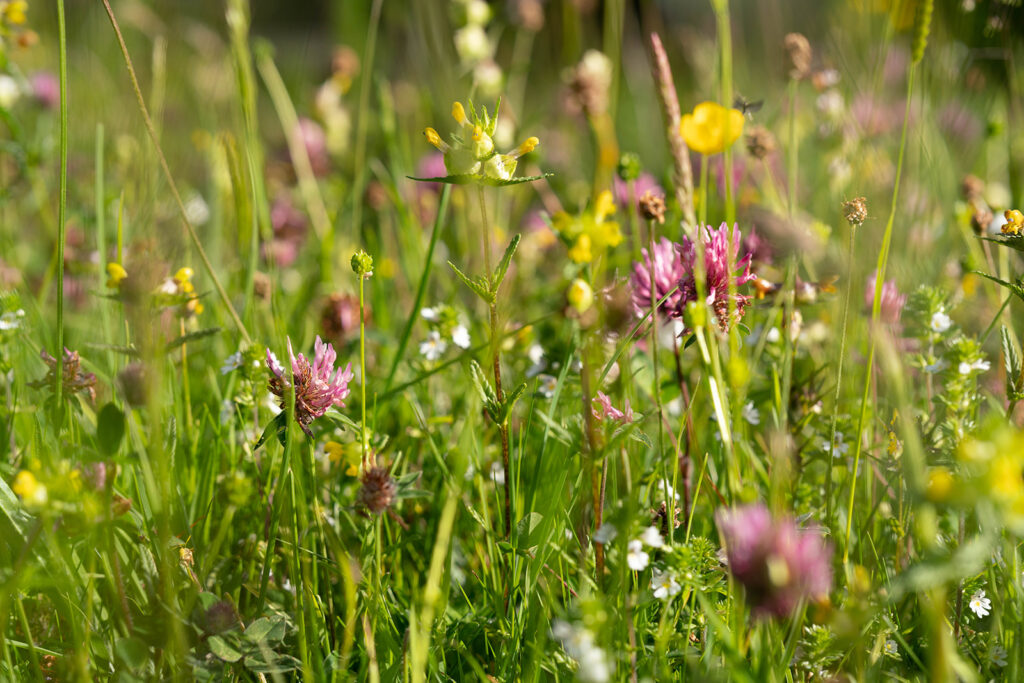Herbal leys – are they for you? We weigh up the pros, the cons and the must-do’s when it comes to growing and feeding sheep and cattle herbal ley.
As Single Farm Payment is phased out and the Sustainable Farming Incentive (SFI) somewhat takes its place, farming herbal leys has become increasingly popular in the UK. Herbal leys now cover approximately 259,700 hectares of British soil. Herbal leys are also gaining traction in Ireland, with Teagasc seemingly firmly behind the ‘regenerative’ approach to farming grassland.
Also known as ‘multi-species swards’, herbal leys include a mix of grasses, legumes, and forage herbs. Specifically: 5 species of grass, 3 species of legumes, and 5 species of herbs or wildflowers. Each species has different functions, so having a diverse mix will work better overall. DEFRA specify that legumes mixed with herbs or wildflowers need to make up at least a quarter of the mix’s weight.
Here’s a breakdown of the different plant species:
- Legumes: Clovers, Birdsfoot trefoil, Lucerne, Sainfoin, Vetches
- Herbs: Plantain, Chicory, Sheep’s parsley, Yarrow, Burnet
- Wildflowers: Burnet, Chicory, Birdsfoot trefoil, Lucerne
- Deep rooters: Chicory, Lucerne, Sainfoin, Cocksfoot, Sheep’s parsley, Burnet, Yarrow, Plantain
- Anthelmintics: Chicory, Sainfoin, Birdsfoot trefoil
Whether or not moving from conventional grass seed mixes to herbal leys is right for you hinges on a number of factors and depends on correct management. So, let’s take a look at the pros and cons.
A Round-Up Of The Herbal Ley Benefits
The main soil/crop benefits:
- Providing resilience in dry periods
- Decreasing reliance on chemical fertilisers
- Extending the grazing season
- Benefiting carbon sequestration
- Increase yield and quality (up to 50% compared to ryegrasses)
- Improving biodiversity of bird and insect species
- Helping control weeds – like blackgrass – in arable rotations
The main livestock benefits:
- Grasses provide an energy source
- Legumes fix nitrogen into the soil and are a source of feed protein
- Herbs/wildflowers provide minerals and micronutrients
- Some herbal ley plant species can help to control parasites naturally
Laying Out The Drawbacks Of Herbal Leys:
- Herbal leys can be difficult and more expensive to establish and maintain. Herbal leys deplete over the course of 3 years
- Herbal leys are more bitter to the taste, impacting on intakes and selective grazing
- There’s no definitive evidence that herbal leys increase average growth rates
- Seasonal nutrient fluctuations reported, exposing livestock to nutrition deficiencies
- Getting an accurate nutritional analysis of herbal leys is challenging
- Herbal leys can have a high mineral but low sugar content, making silage fermentation challenging
- Some plants, such as chicory, develop tough stems that animals won’t graze and won’t wilt very well
The major concern with herbal leys is the danger of using the wrong sites in the wrong way or at the wrong scale. This can actually cause a loss of habitat and species.
The Herbal Ley Sugar Challenge
As already mentioned, one of the major benefits of feeding herbal leys – in comparison to conventional grasses – is the positive impact on protein, mineral and trace element levels. A 2024 trial study, which observed a herbal ley and grass-clover lay over two seasons, found increases in both macronutrient and micronutrient concentrations.
However, depending on how much grass is in the mix, the overall sugar status of the herbal ley can be relatively lower and so needs careful management to maintain productivity.
Sugar is vital for fermentation – whether that is in the clamp or in the rumen. Amongst many other factors, the ability of the ruminant to convert forage into meat and milk depends on…sugar.
When forage is low in sugar – forage digestion, rumen turnover and dry matter intakes – are all impacted.
While herbal leys may reduce reliance on supplements, in some situations where they are well established, they do not eliminate the need for strategic mineral and energy supplementation. This is especially important during winter and critical production phases (e.g., pre-lambing).
Introducing Sugar Into The Herbal Ley Diet
With grazing supplementation, there’s a few options to go at – buffer feeding, in-parlour feeding, or offering a feed lick. Here’s the benefits of opting for a feed lick:
Benefit 1: Feed licks, being molasses-based, are highly palatable. This attracts frequent visits and intakes, even when there is plenty of grazing available. Select a feed lick with a hard crystalline structure to prevent gorging and instead ensure a little-and-often intake.
Benefit 2: Feed licks are available for livestock to consume around-the-clock, providing a consistent supply of sugar, and preventing peaks and troughs in rumen pH. Look out for the relative sugar (energy) levels per kg, as some blocks are more energy-dense than others.
Benefit 3: Feed licks are quick and easy to supply, freeing up time for other summer tasks. Ensure you offer the correct number of feed licks and ensure the feed licks can stand up to wet conditions.
Can You Justify The Extra Spend?
Through offering livestock that consistent supply of sugar, Crystalyx is research-proven to increase digestion by 10% and dry matter intake by 15% – helping to ensure livestock performance on herbal leys.
Secondly, and perhaps most important to mention, is the fact that Crystalyx lasts up to 3X longer than many other feed licks on the market. This is down to the fact that Crystalyx is manufactured using a unique cooking process to ensure a consistent low moisture status (2-3%) and a hard crystalline structure.


